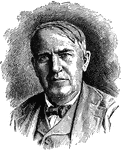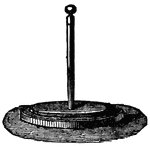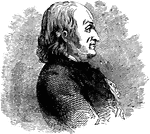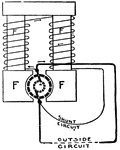
Dynamo
"The dynamo has its field mangets F F magnetized by means of a small current flowing around a shunt…
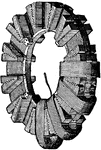
Dynamo Machine
The armature of a dynamo machine by Brush Electric Company. The dynamo machine, now known as an electrical…

Dynamo Machine
The dynamo machine, now known as an electrical generator, is a device that converts mechanical energy…

Brush dynamo
"A shaft runs through the machine from end to end, carrying a pulley, P, at one end, a commutator, c,…
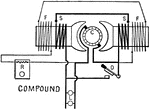
Compound wound dynamo
"Compound wound dynamo, used when better automatic regulation of voltage on constant pressure circuits…

Connected dynamo and motor
"Where a motor is connected with the electric circuit of a dynamo...and the armature of the dynamo is…

Seperately excited dynamo
"Separately excited dynamo. Current for field excitation is supplied by a second and smaller generator."…

Series dynamo
"The electromagnet that supplies the flux of force must have a current to excite it. This current is…
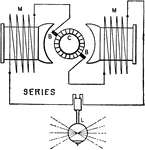
Series wound dynamo
"Series wound dynamo, used for series aarc lighting, and as a booster for increasing the pressure on…
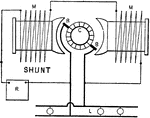
Shunt dynamo
"The shunt wound dynamo differes from the series wound machine, in that an independent circuit is used…

Shunt Wound Dynamo
"When a dynamo is so constructed that only a smal part of its current is employed to magnetize its field-magnet,…
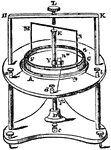
Electric Apparatus
"ABC is a horizontal coil of wire terminating at the binding screws a, b. FG is a ring-shaped trough…

System of Incandescent Lights
The System of Incandescent Lights is a device in which electric light is obtained by conducting a current…

Electric Machine
Thomas Edison's original concept of the electric machine, an electricity generator distributed to homes,…

Electric Wire Insulator
An insulator is a material that resists the flow of electric current. An insulating material has atoms…
Kinnersley electrical air-thermometer
"Various methods have been devised for measuring electrostatic quantity, one of the simplest of which…

Electricity
This illustration shows the field between two equally and oppositely charged spheres, mapped out by…
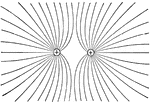
Electricity
This illustration represents the field between two equal positive charges; in this case the lines of…

Electricity
This illustration shows the lines of force when a positive charge equal to 4 at A, and a negative charge…
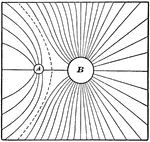
Electricity
This illustration shows the field of force due to a charge 1 at A, and a like charge 4 at B.

Electricity
This illustration shows the field of force between two parallel planes. At the edges its lines of foce…

Electricity
A is a positively charged conductor and B represents the equal and oppsite charge. When the conductor…
Electromagnet
"An electromagnet is a bar of iron magnetized by an electric current, substantial as just shown." —…

Electromagnet
"When an electromagnet is U-shaped, the coils around the two ends of the bent iron core are so wound…
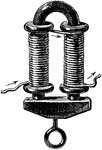
Electromagnet
"A magnet which owes its magnetic properties to the inductive action of an electric current." -Whitney,…

Quadrant Electrometer
An illustration of a quadrant electrometer. An electrometer is an electrical instrument for measuring…
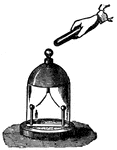
Electroscope
Apparatus for showing the presence of electricity without giving quantitative measurements.
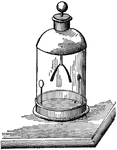
Electroscope
"The electroscope is an instrument for detecting and testing electrification. A metallic rod passes…

Electroscope
"One of the simplest instruments of this kind consists of a metallic needle, terminated at each end…

Condensing Electroscope
"An instrument for observing or detecting the existence of free electricity, and, in general, for determining…

Gold Leaf Electroscope
"In the gold-leaf electroscope (invented by Bennet in 1787), two light strips of gold-leaf hang from…

Pith-Ball Electroscope
"An instrument for observing or detecting the existence of free electricity, and, in general, for determining…
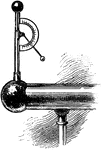
Quadrant Electroscope
"An instrument for observing or detecting the existence of free electricity, and, in general, for determining…
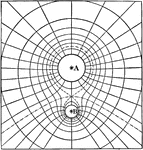
Equipotential
"Equipotential Lines about two similarly electrified spheres, A and B, the quantities of electricity…
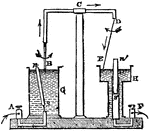
Faraday Apparatus
"This apparatus shows the rotation at once of a magnet and of a movable conductor. The rotating pieces…

Faraday Experiment
"Faraday used in his experiments two identical pieces of apparatus, which were vertually two spherical…

Four-Plate Machine
"Machines of this kind may be constructed with as many pairs of plaes, combs, and brushes as can be…
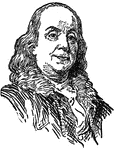
Dr. Benjamin Franklin
(1706-1790) United States diplomat, inventor, politician, and printer. Invented the Franklin stove,…
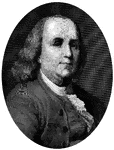
Dr. Benjamin Franklin
(1706-1790) United States diplomat, inventor, politician, and printer. Invented the Franklin stove,…
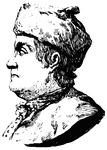
Dr. Benjamin Franklin
(1706-1790) United States diplomat, inventor, politician, and printer. Invented the Franklin stove,…

Frictional Electric Machine
Now known as electrostatic generators, the Frictional electric machine produces static electricity at…
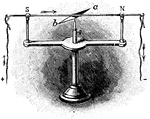
Galvanometer
A galvanometer is a type of ammeter; an instrument for detecting and measuring electric current. It…


